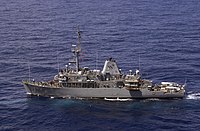
Photo from wikipedia
Abstract The utilization of ROV (Remotely Operated Vehicle) for subsea operation has been increasing in the past few years alongside the increasing use of subsea technologies in deep-water oil and… Click to show full abstract
Abstract The utilization of ROV (Remotely Operated Vehicle) for subsea operation has been increasing in the past few years alongside the increasing use of subsea technologies in deep-water oil and gas activities and other maritime operations. While survey class ROVs have reached the deepest depth in the ocean, the work class ROVs are mostly limited to 3 km depth. For a work class ROV operating in deep waters, the excessive static tension due to self-weight of the ROV and its umbilical system leaves small room before the dynamic tension exceeds the safe working load of the umbilical. Snap loads can also exist in the low-tension area of the umbilical when the ROV system is under dynamic motions which can lead to a large tensile load in the line. Therefore, there is a need for a practical solution to ensure that the safe working load is not exceeded during ultra-deep-water operation. This study focuses in reducing the tension in the umbilical hence increasing the operational depth of a work class ROV from deep to ultra-deep waters. Three different configurations, namely the hook, hook & top floaters, and mid-depth hook are numerically investigated and compared with the conventional free-flying ROV configuration. Firstly, deep-water operation of a 3 km ROV system is simulated under combination of a real extreme vertical current profile and various irregular wave conditions. This shows negligible effect of the current profile on umbilical maximum tension. The study also shows that for 3 km ROV operation, the suggested hook configuration is sufficient to effectively reduce the tension load as well as reducing the possibility of snap in the umbilical. Using hook configuration in the umbilical has significant benefits in minimizing ROV motion and also filters out the destructive snap induced high frequency tension fluctuations in the umbilical. For 6 km operation, either hook & top floaters or mid-depth hook can be utilized whereas the mid-depth hook configuration provides a broader environmental operating window for ROV operation. However, installation of floaters on the umbilical to produce the mid-depth hook configuration increases the ROV offset.
Journal Title: Ocean Engineering
Year Published: 2021
Link to full text (if available)
Share on Social Media: Sign Up to like & get
recommendations!